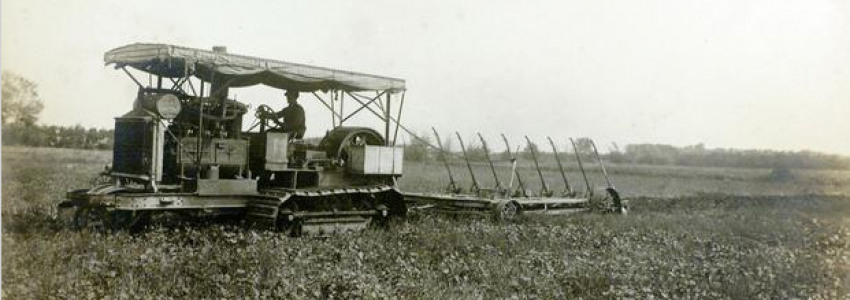
Kitmondo
17 Sep 2018
If we say “heavy machinery”, most of us will imagine a huge construction crane towering over the tallest buildings in a modern city or heavy industrial vehicles causing traffic and slowing us down on the way to work. If we ask our kids, they will probably answer a tractor or a bulldozer. But have any of us really thought about how useful these units are and how complex the work is they are able to do?
Look around while walking through the city, all these buildings around us would not be here without this powerful technology. Also, thanks to the years of evolution of the heavy equipment industry, the agriculture has become much easier for farmers than it was hundred years ago.
To give tribute to this technological progress let’s get to know a little of the history of industrial machines from animal-drawn tools to modern technology. It is always useful knowing a little history of the industry you are working in.
At the beginning there was a horse
At the beginning of agricultural and construction work, there were animal-drawn tools. Used machines couldn’t generate their own power and needed the power of a human or animal. For many years people and animals bore all heavy work on their shoulders. As anyone can imagine, humans and animals have limited strength and only small projects could have been done at that time. Larger projects were extremely complicated and could take centuries.
For agricultural purposes, mainly animal-drawn tools powered by horses or oxen were used. The majority of heavy agricultural work was carried out by the farmers themselves. The big change came in 1800’ during the Second Industrial Revolution in the USA.
Second industrial revolution
The second Industrial Revolution could be also called a revolution of agricultural machinery. The beginning of the long development of the agriculture industry had begun. New tools were being constructed to help farmers’ daily work.
In 1886, American inventor Benjamin Holt constructed the first combine harvester. Only a few years later the first tractors were constructed. First, it was the steam engine tractor in 1890. Only two years later, John Froelich invented the gas-powered tractor.
These inventions directed the way for years of the heavy equipment industrial development.
The largest heavy equipment
In 1906, Benjamin Holt came up with a gas-powered truck-type tractor which helped many industries in their developments. This invention jump started the development of agriculture, commercial and military vehicles.
The 1920’s was a time for mining precious minerals. As the demand for mining equipment was growing, manufacturers took the opportunity to design the largest heavy equipment of that time. Many companies were becoming stronger.
In the 1930’s, the Great Depression influenced the heavy machinery market. Most of the manufacturing companies were struggling and made the decision to sell abroad to avoid bankruptcy.
Construction equipment boom
Let’s have a look at the history of construction equipment from the year 1950 when the big boom of heavy equipment production started.
Between the years of 1950 and 1980 there was substantial growth of the heavy construction market. After World War II, the expansion of suburban residential and commercial sites had started. That was the reason that the heavy equipment was needed. Besides building and expanding big cities, the interstate highways had begun to be built.
The need for moving a massive amount of material across countries caused the start of construction of the highways as we know them today. In 1956 the Interstate Highway System began development and continued for another 35 years.
The interstate highway was a really unique construction which required completely new types of machines as well as many improvements on old units. The biggest upgrades included the size and design of the machines. The 1960’s could be also called the decade of monster machines. After that time, engineers were more focused on productivity and efficiency over the size of the equipment.
In 1973, countries were blocked by the Arab oil embargo. This situation increased the demand for the coal. Demanding work such as digging, raising, hauling or dumping was needed more than before, and earthmoving equipment on the market was lacking. Companies had to wait 3-4 years for the arrival of efficient earthmoving equipment. The heavy equipment market was growing at great speed.
A decline of the heavy equipment demand
The 1980’s came and turned out to be a rough time for the heavy equipment industry. As the highways were already finished, the demand for machinery declined. Construction companies were closed or, in better cases, merged. It was also the time when the company Caterpillar gained the first position of the manufacturers in the heavy equipment market.
An environmental regulations
The beginning of the 1990’s new environmental regulations increased the demand again. Heavy equipment needed a change of engines to become more friendly to the environment. The construction industry had to lower carbon emission. Manufacturers of construction equipment took this opportunity to also upgraded the design of machines.
After 2000, manufacturing companies continued with innovations in fuel efficiency and carbon emission to reduce fuel costs and environmental impact. The goal was to minimize pollution caused by using construction equipment.
What will be next?
What can we expect in the future of heavy equipment? As the technology is rapidly evolving, it is only matter of time until new advanced multifunction heavy equipment tools will be launched. The innovators of manufacturing companies are working constantly to come up with new time and cost effective tools.
New commercial and residential sites are still being built and the demand for heavy equipment is steadily growing. This involvement should continue for years to come.
















